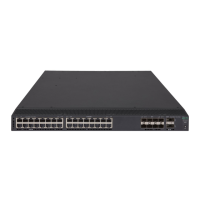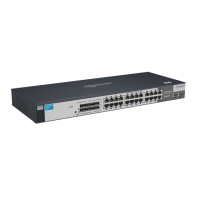13
FCoE configuration guidelines
Configuring the switch to operate in advanced
mode or expert mode
The switch supports FCoE only when it is operating in advanced mode or expert mode. For more
information about system operating modes, see Fundamentals Configuration Guide.
The switch supports FCoE over S-channel only when it is operating in expert mode. FCoE over S-Channel
allows you bind a VFC interface to an S-channel interface. For more information about binding a VFC
interface to an S-channel interface, see FCoE Command Reference.
Configuring an FCoE mode
An FCoE-capable switch can operate in FCF, NPV, Transit, or non-FCoE mode.
To configure a switch operating in one FCoE mode to operate in another FCoE mode, follow these steps:
1. Configure the switch to operate in non-FCoE mode.
2. Configure the switch to operate in the target FCoE mode.
After you configure the switch to operate in non-FCoE mode, FCoE-related configurations in the original
FCoE mode are cleared.
To configure an FCoE mode for a switch:
Ste
Command
Remarks
1. Enter system view.
system-view N/A
2. Configure an FCoE mode
for the switch.
fcoe-mode { fcf | npv |
transit }
By default, a switch operates in non-FCoE
mode.
Before configuring FCoE features on a
switch, you must configure an FCoE mode
for the switch.
3. Display an FCoE mode of
the switch.
display fcoe-mode Available in any view.
FCoE features supported in different FCoE modes
The switch supports the following FCoE modes: FCF mode, NPV mode, and Transit mode. Each mode
supports different FCoE features, as shown in Table 1.
You can choose to configure different features
based on the FCoE mode of a switch.
